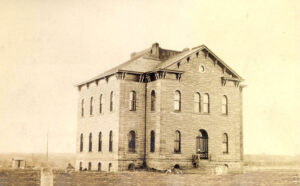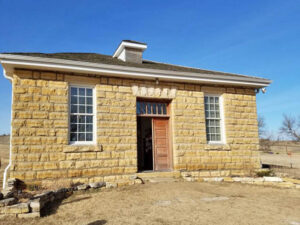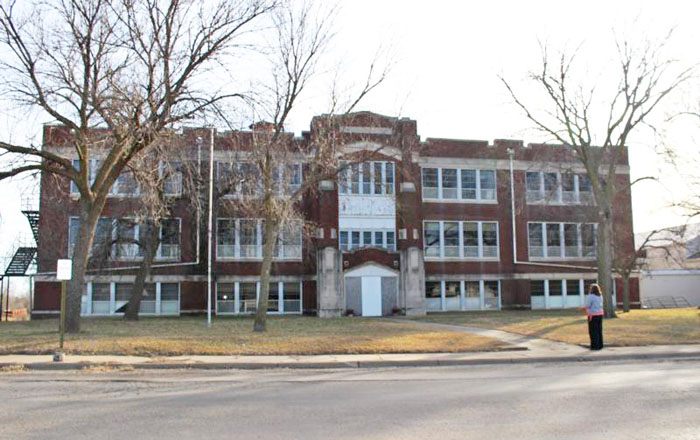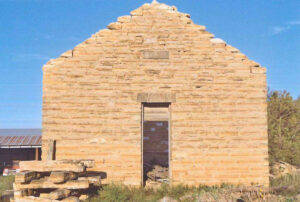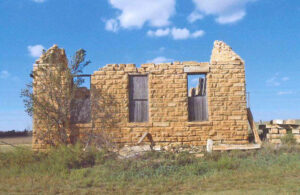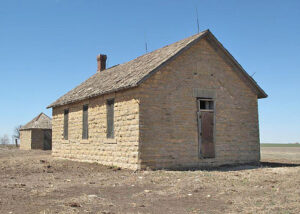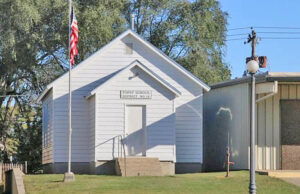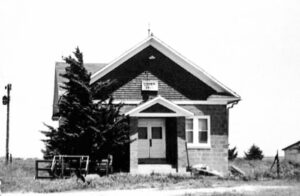
Ash Grove, Kansas.
The first thought of Lincoln County, Kansas, pioneers was for their children’s education. In 1870, a young man named Marion Ivy taught the first school in a dugout in Martin Hendrickson’s dooryard. David G. Bacon taught the second school in a dugout nearby. In 1870, Mrs. Skinner taught the first public school in District No. 2 at Monroe. Washington Smith, the county superintendent, organized the first school district the following year.
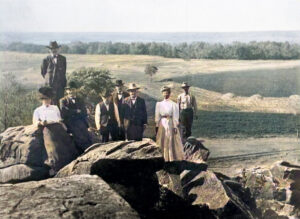
Lincoln County, Kansas Pioneers at a cave on Bull Foot Creek, in about 1900.
Mrs. Anna C. taught the first school in Lincoln Center in 1872, in a 14×20 foot room. There were 30 students, and as this room was the kitchen, parlor, dining room, and bedroom for the Wait family, it was a little crowded. By the early 1890s, the school enrolled 500 students and employed seven teachers. A substantial building, heated by steam, replaced the 14×20 room. The building, though comparatively small, was one of the best in the state. It could seat 600, and costs, including the steam heating apparatus, were about $18,000. J.D. Miller, Ira W. Russell, C.T. Pickett, J. A. Schofield, N. Coover, S. V. Mallory, J. Sonnedecker, R.A. Hampshire, and J.H. Ware have had charge of the school. The county superintendents were John Lyden, Washington Smith, J.H. Wright, J.P. Harman, A.T. Biggs, H. B. Harris, J.H. Allsworth, and A.T. Biggs. Mr.Allsworth served two terms, and Mr. Biggs five. Mr. Smith was appointed to fill a vacancy caused by the refusal of John Harshbarger, who had been elected, to qualify. The superintendent elected was Horace Truman.
Early in 1872, when it had become relatively settled that Lincoln Center would forever be the county’s capital, the people of School District No. 6 voted $3,500 in bonds for the erection of a handsome stone schoolhouse, which was built the following summer. It measured 38 x 42 feet, was two stories high, and was built of magnesian limestone.
The attendance has risen from 23, in 1877, to 155, in 1892. In 1877, Lincoln’s business and professional men enrolled and paid the fee to secure the $50 appropriation from the State. The large attendance of the last year was mainly due to the desire of the teachers to take lessons in mathematics and psychology under the veteran schoolmaster, Doctor Schuyler. Among the prominent teachers may be mentioned John A. Schofield, a soldier in the Civil War, who has been constantly teaching since; Mrs. Anna C. Wait, who has taught about 200 weeks in three or four different States, and, though not now teaching, took an active interest in education, and the earnest, honest teacher finds in her a friend and counselor; Mrs. Susan S. Smith, who had been actively engaged in teaching for 30 years, and who has long enjoyed the distinction of standing at or near the head of the class of first-class teachers; J.H. Ware, for the last eight years principal of the Lincoln Center schools, who has had some 16 or 18 years experience in teaching, in addition to serving four years as county superintendent in Iowa. Mrs. Moss, the primary teacher in the Lincoln schools, is a veteran of some 18 years of experience and one of the heaven-made variety. Horace Truman, the county superintendent elect, is a young man with brains, energy, and pure motives. He has taught in Lincoln County for 15 years and has been an assistant principal for four years in Lincoln. The outgoing superintendent’s meager education was acquired by studying the light of pine knots back among the hills of southeastern Ohio, where he began teaching 33 years ago when he was 15. He attributed his success in teaching and his ten years of superintendency to his love for children and work. One of the most serious hindrances to uniform success in the schools of this county was iniquitous method of taxation, whereby one district can maintain a nine-month school with a 3-mill levy.
In contrast, an adjoining district could only maintain a four-month school with a 20-mill levy. The State ought to be the unit of taxation for school purposes. Among the drawbacks are the short tenure of office and the very tender age of many teachers. Very young teachers sometimes succeed.
In 1882, the school board comprised R.F. Bryant, C.G. Wood, J.B. Goff. At that time, the school had an average daily attendance of 103 and was presided over by James Mallory, assisted by Mrs. Burress. At that time, the county had 78 school districts with good, comfortable buildings valued at $19,250. The school expenses for the year ending July 31, 1882, were $10,935. The county had 2,888 children of school age, 2,267 of whom were enrolled and 1,510 of whom were in daily attendance. The average salary of male teachers was $25 per month, and for females, $22.
In 1893, 85 districts employed 94 teachers and a school population of 3,600.
Kansas Christian College – The Kansas State Christian Conference, by resolution passed October 20, 1882, instructed its board of trustees to locate and establish a school in central Kansas. The propositions of different localities were not acted upon until January 31, 1884, when that of Lincoln, Lincoln County, Kansas, was accepted. The Lincoln College Building Association was then formed and chartered, and the final contract between this association and the trustees of the Kansas State Christian Conference was signed on March 24, 1884. By the terms of this contract, the association was to erect a suitable college building at the cost of not less than $10,000. When the Christian Conference raised an endowment equal to the cost of the building, the college property was to be conveyed by deed to the conference. The erection of the building was begun in 1884, but, owing to financial depression, the work proceeded slowly, and, in 1892, the building association tendered the State Conference the right and title of the property, which proposition was accepted; thus, the control of the property, as well as of the school, passed into the hands of the trustees of the college. The Honorable Thomas Bartlett was chosen as the college’s first president and served until the close of the school year in 1891, when, owing to failing health, he resigned. A preparatory school was begun in the Baptist Church in Lincoln on April 21, 1884, by Reverend George Jenney. The college proper was opened in September of the same year under the superintendence of President Bartlett. The building was a substantial stone structure that accommodated about 150 students when classes began in 1885. The college was discontinued in 1913.
Historic Schools of Lincoln County
| School | District | Years of Operation | Description |
| Cedron | 17 | 1910-?? |
This limestone schoolhouse is about two feet longer and wider than the standard one-room schoolhouse. 541 E. Union Drive is 1/2 mile south of E Union Drive and two miles west of Ash Grove in Cedron Township near Sylvan Grove. |
| Ash Grove | 16 | ??-1966 | The weathered clapboard building still stands |
| Evangelical Lutheran School | NA | 1913-1981 | The Evangelical Lutheran School is located on the east edge of Sylvan Grove, directly north of the Bethlehem Lutheran Church. The school is associated with the early German Lutheran immigrants who settled there. |
| Gorge School | 44 | 1893-1947 |
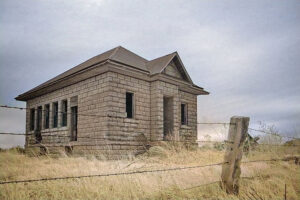 Gorge School by Scott Branine Flickr. |
| Lincoln High School | 298 | 1922-1996 |
The old Lincoln High School is a three-story Collegiate Gothic building located six blocks south of downtown Lincoln. The symmetrical front facade faces north (College Avenue) and is defined by a projecting entry bay, common to Progressive Era Schools. The gabled center bay embodies detailing characteristics of the Collegiate Gothic style, including pointed arch surrounds, buttress-like pilasters, and stone detailing. The east facade provides access to the central corridor leading to the combined auditorium/gymnasium. A one-story corridor was built connecting the school to the 1960 band room, and a private business now occupies the shop addition. A new high school was constructed in 1996, and the old school was closed, standing vacant. The two-and-a-half-story red brick building was placed on the National Register of Historic Places in February 2020. It is located at 700 South 4th Street in Lincoln, Kansas. |
| Logan Center | 76 | Logan Township. This red brick school is deteriorating. | |
| Lost Creek Yauger | 6 | 1870-1894 |
The old Lost Creek Yauger School served as a school and the First Christian Church from 1870 to 1894. The one-story stone schoolhouse was built in the Vernacular style, with three north and south bays and an east entrance. The gabled roof is gone. This is a Lincoln County Historical Site. It is located at 1418 North 180 Road in Marion Township in the Lincoln vicinity. It is 1.5 miles North and a half mile west of Lincoln, Kansas. |
| Margaret | 43 | 1884-1965 |
The old Margaret School is a rectangular school built in the Vernacular style. The school reportedly closed after the 1965 school year – one of the area’s last one-room schools to function as a school. There are also two limestone outhouses and a limestone coal shed on the property. It is located at 789 East Bison Drive on the southwest corner of East Bison Drive and North 8th Road. It is about 14 miles southeast of Sylvan Grove. |
| Spring Valley | 11 | Small wooden school in ruins. It is on top of a hill. | |
| Topsy | 18 | 1940 |
This one-story rectangular wood-frame building built in the vernacular style has a front-facing gable roof and a small gable enclosure at the front entry in the center of the south facade. The Topsy school was located west of the Lincoln County extinct town of Westfall and was moved to the Lincoln County Historical Museum site in 1988. It is located at 208 W. Lincoln Avenue in Lincoln, Kansas. |
| Twin Grove | 14 | 1870-1947 | Pleasant Township. Small brick school In ruins. |
| Union | 4 | ?? |
The old Union School is a one-story red brick tile building with a cross-gable roof designed in the vernacular style. It is presently used for storage and is located ten miles North and six miles west of Lincoln, Kansas. |
Historic School Districts of Lincoln County
| School | District | Township | Dates |
| Allamead | 52 | Orange | |
| Amsterdam | 85 | Vesper | |
| Ash Grove | 16 | Orange | |
| Barnard | 84 | Scott | |
| Bashan | 15 | Elkhorn | |
| Beulah or Olivet | 46 | Beaver | |
| Beaver | 21 | Beaver | |
| Beverly | 1 | Colorado | |
| Bismark | 34 | Battle Creek | |
| Blue | 62 | Highland | |
| Cedron | 17 | Cedron | |
| Climax | 82 | Hanover | |
| Cottonwood | 7 | Battle Creek | |
| Denmark | 12 | Grant | |
| Dew Drop | 29 | Marion | |
| Donley | 8 | Franklin | 1893-1917 |
| Dry Creek | 65 | Scott | |
| Elkhorn | 9 | Salt Creek | |
| Elkvale | 78 | Valley | |
| Elm Creek | 54 | Cedron | |
| Fairview | 4 | Colorado | 1893-1912 |
| Fairview | 55 | Hanover | |
| Freedom | 39 | Madison | |
| Garfield | 68 | Marion | |
| Golden Belt | 66 | Golden Belt | |
| Gorge | 44 | Pleasant | 1893-1947 |
| Green Valley | 36 | Cedron | |
| Ingalls | 57 | Cedron | |
| Keystone | 53 | Madison | |
| King | 72 | Salt Creek | |
| LaBar (Owl Creek) | 51 | Colorado | |
| Liberty | 71 | Valley | |
| Lincoln | 6 | Elkhorn | |
| Logan Center | 76 | Logan | |
| Lone Rock | 79 | Vesper | |
| Lone Star | 74 | Franklin | |
| Long Grove | 60 | Orange | 1893-1920 |
| Madison | 48 | Madison | |
| Malone | 22 | Marion | |
| Margaret | 43 | Golden Belt | |
| Milo (also #10) | 67 | Salt Creek | |
| Monroe | 2 | Colorado | |
| Mount Ayer | 77 | Highland | |
| Mount Pleasant | 23 | Pleasant | |
| Mount Pleasant | 31 | Cedron | |
| Mt. Pleasant/Topsy | 18 | Franklin | |
| North Denmark | 81 | Grant | 1894-1917 |
| North Ireland | 20 | Indiana | 1893-1917 |
| Oak Creek | 38 | Vesper | |
| Old Vesper | 13 | Vesper | 1893-1914 |
| Old Vesper | 49 | Vesper | 1891-1914 |
| Orange | 32 | Orange | |
| Orbitello | 70 | Highland | |
| Paris | 42 | Battle Creek | |
| Pinon | 26 | Scott | |
| Pleasant Dale | 69 | Elkhorn | |
| Pleasant Hill | 64 | Logan | |
| Pleasant Valley | 5 | Indiana | |
| Pleasant View | 63 | Indiana | 1893-1912 |
| Pottersburg | 19 | Grant | |
| Prairie Grove | 25 | Battle Creek | |
| Prairie Star | 59 | Logan | 1893-1921 |
| Pugh | 80 | Golden Belt | |
| Red Rock | 87 | Elkhorn | |
| Rocky Hill | 3 | Elkhorn | |
| Rocky Point | 35 | Scott | |
| Rosette | 56 | Hanover | |
| Shiloh | 41 | Cedron | |
| South Ireland | 27 | Indiana | 1893-1914 |
| Spring Valley | 11 | Spring Valley | |
| Star | 24 | Scott | |
| Sunnyside | 45 | Beaver | |
| Sunrise | 30 | Madison | |
| Surprise | 58 | Marion | |
| Sylvan Grove | 28 | Pleasant | |
| Tablerock | 73 | Colorado | |
| Trail Creek | 40 | Orange | |
| Twelve Mile (Shady Bend) | 33 | Colorado | |
| Twin Grove | 14 | Pleasant | |
| Twin Mound | 47 | Franklin | |
| Union Valley | 37 | Golden Belt | |
| Upper Twelve Mile | 61 | Logan | |
| West Point | 86 | Hanover | |
| Westfall | 88 | Madison | |
| Willow Glen | 75 | Grant |
©Kathy Alexander/Legends of Kansas, updated August 2024.
Also See:
Sources:
Columbian History of Education in Kansas, Compiled by Kansas Educators, Kansas State Historical Society, 1893.
Cutler, William G; History of Kansas; A. T. Andreas, Chicago, IL, 1883.
RootsWeb


